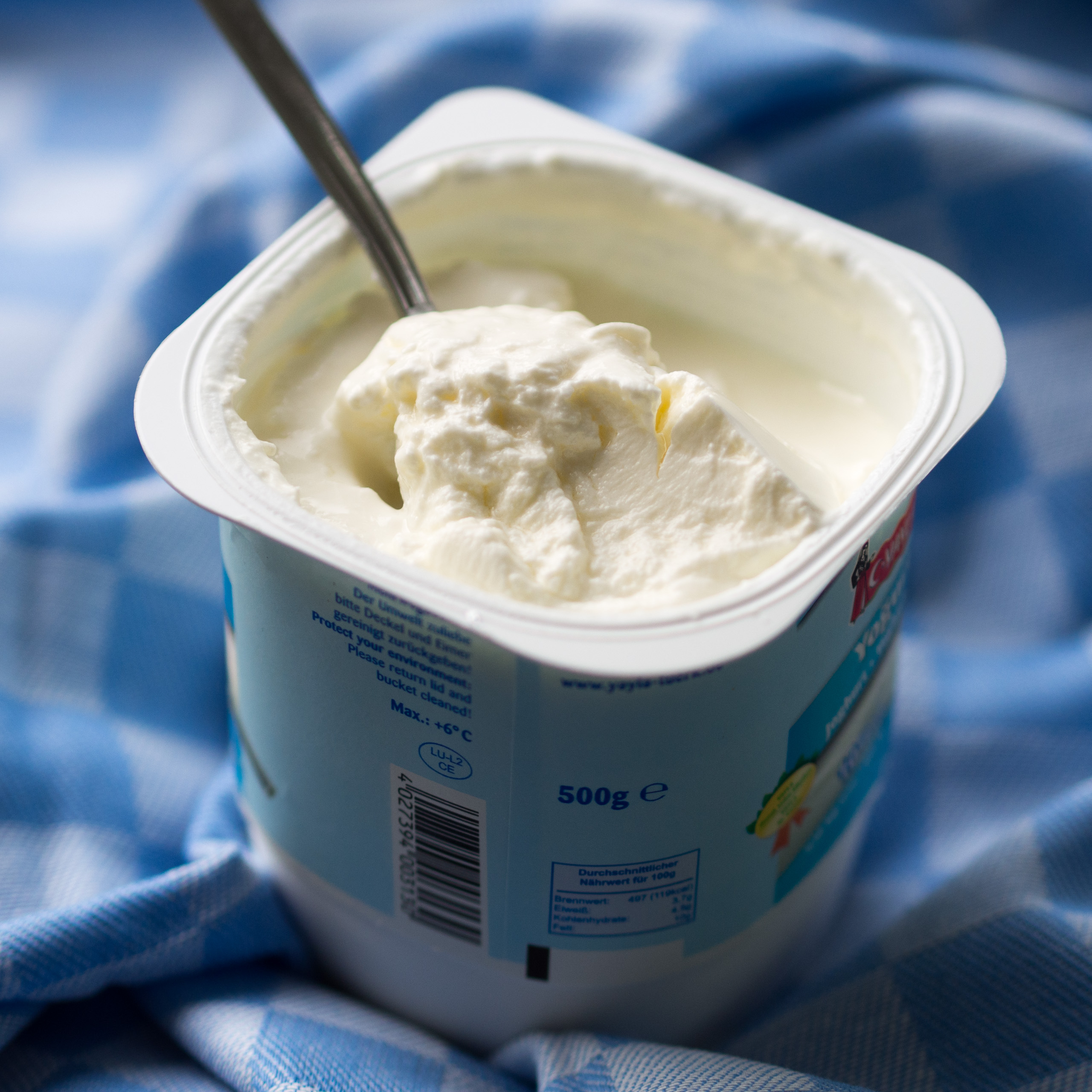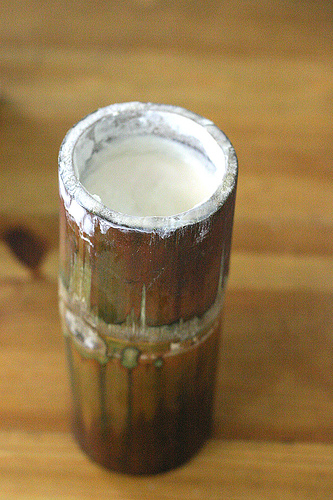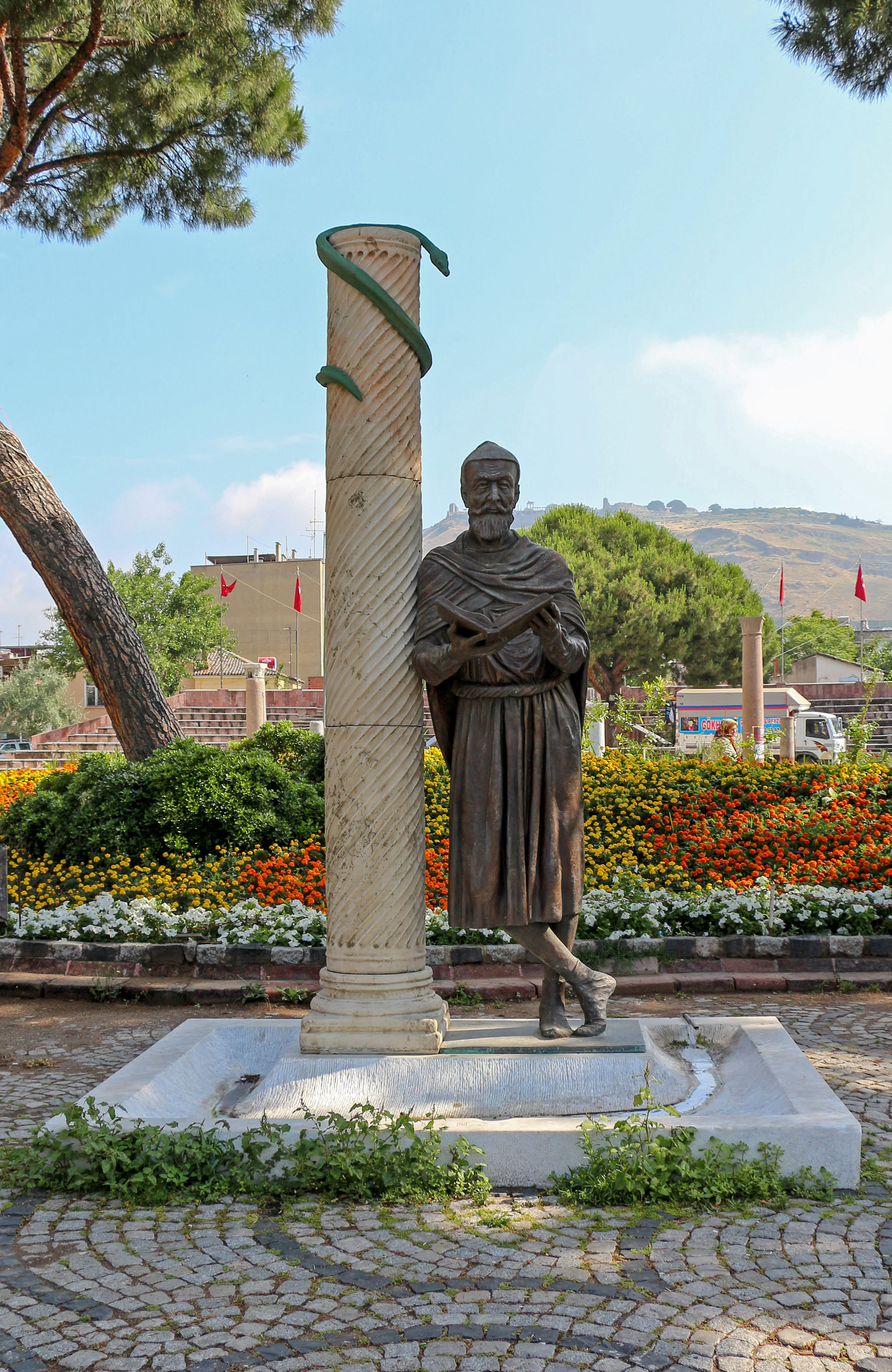|
Yoghurt
Yogurt (; , from , ; also spelled yoghurt, yogourt or yoghourt) is a food produced by bacterial fermentation of milk. Fermentation of sugars in the milk by these bacteria produces lactic acid, which acts on milk protein to give yogurt its texture and characteristic tart flavor. Cow's milk is most commonly used to make yogurt. Milk from water buffalo, goats, ewes, mares, camels, and yaks is also used to produce yogurt. The milk used may be homogenized or not. It may be pasteurized or raw. Each type of milk produces substantially different results. Yogurt is produced using a culture of ''Lactobacillus delbrueckii'' subsp. ''bulgaricus'' and ''Streptococcus thermophilus'' bacteria. Other lactobacilli and bifidobacteria are sometimes added during or after culturing yogurt. Some countries require yogurt to contain a specific amount of colony-forming units (CFU) of bacteria; for example, in China the requirement for the number of lactobacillus bacteria is at least 1 million ... [...More Info...] [...Related Items...] OR: [Wikipedia] [Google] [Baidu] |
Fermented Dairy Product
Fermented milk products or fermented dairy products, also known as cultured dairy foods, cultured dairy products, or cultured milk products, are dairy foods that have been made by fermenting milk with lactic acid bacteria such as ''Lactobacillus'', '' Lactococcus'', and '' Leuconostoc''. The fermentation process increases the shelf life of the product while enhancing its taste and improving the digestibility of its milk. There is evidence that fermented milk products have been produced since around 10,000 BC. A range of different Lactobacilli strains has been grown in laboratories allowing for many cultured milk products with different flavors and characteristics. These bacteria allow the production of many fermented milks such as cheese, yogurt, kefir, butter Most of the bacteria needed to make these product thrive under specific conditions, meaning that the right environment is crucial to the making of the fermented products. Products Many different types of cultured ... [...More Info...] [...Related Items...] OR: [Wikipedia] [Google] [Baidu] |
Lactic Acid
Lactic acid is an organic acid. It has the molecular formula C3H6O3. It is white in the solid state and it is miscible with water. When in the dissolved state, it forms a colorless solution. Production includes both artificial synthesis as well as natural sources. Lactic acid is an alpha-hydroxy acid (AHA) due to the presence of a hydroxyl group adjacent to the carboxyl group. It is used as a synthetic intermediate in many organic synthesis industries and in various biochemical industries. The conjugate base of lactic acid is called lactate (or the lactate anion). The name of the derived acyl group is lactoyl. In solution, it can ionize by a loss of a proton to produce the lactate ion . Compared to acetic acid, its p''K'' is 1 unit less, meaning lactic acid is ten times more acidic than acetic acid. This higher acidity is the consequence of the intramolecular hydrogen bonding between the α-hydroxyl and the carboxylate group. Lactic acid is chiral, consisting of two en ... [...More Info...] [...Related Items...] OR: [Wikipedia] [Google] [Baidu] |
Dairy Product
Dairy products or milk products are food products made from (or containing) milk. The most common dairy animals are cow, water buffalo, goat, nanny goat, and Sheep, ewe. Dairy products include common grocery store food around the world such as yogurt, cheese, milk and butter. A facility that produces dairy products is a ''dairy''. Dairy products are consumed worldwide to varying degrees. Some people avoid some or all dairy products because of lactose intolerance, veganism, Environmental issues, environmental concerns, other health reasons or beliefs. Types of dairy product Milk Milk is produced after optional Homogenization (chemistry), homogenization or pasteurization, in several grades after standardization of the fat level, and possible addition of the bacteria ''Streptococcus lactis'' and ''Leuconostoc citrovorum''. Milk can be broken down into several different categories based on type of product produced, including cream, butter, cheese, infant formula, and yogurt. ... [...More Info...] [...Related Items...] OR: [Wikipedia] [Google] [Baidu] |
Ghayn
The Arabic letter (, or ) is one of the six letters the Arabic alphabet added to the twenty-two inherited from the Phoenician alphabet (the others being , , , , ). It represents the sound or . In name and shape, it is a variant of ʻayn (). Its numerical value is 1000 (see Abjad numerals). In Persian, it represents ~ and is the twenty-second letter in the new Persian alphabet. ' is written in several ways depending on its position in the word: History Proto-Semitic (usually reconstructed as voiced velar fricative or voiced uvular fricative ) merged with ʻayn in most Semitic languages except for Arabic, Ugaritic and older varieties of the Canaanite languages. The South Arabian alphabet retained a symbol for , . Biblical Hebrew, as of the 3rd century BCE, apparently still distinguished the phonemes and , based on transcriptions in the Septuagint, such as that of the name " Gomorrah" as ''Gomorrha'' () for the Hebrew ''‘Ămōrā'' (). Canaanite languages, inclu ... [...More Info...] [...Related Items...] OR: [Wikipedia] [Google] [Baidu] |
Honey
Honey is a sweet and viscous substance made by several species of bees, the best-known of which are honey bees. Honey is made and stored to nourish bee colonies. Bees produce honey by gathering and then refining the sugary secretions of plants (primarily floral nectar) or the secretions of other insects, like the honeydew of aphids. This refinement takes place both within individual bees, through regurgitation and enzymatic activity, and during storage in the hive, through water evaporation that concentrates the honey's sugars until it is thick and viscous. Honey bees stockpile honey in the hive. Within the hive is a structure made from wax called honeycomb. The honeycomb is made up of hundreds or thousands of hexagonal cells, into which the bees regurgitate honey for storage. Other honey-producing species of bee store the substance in different structures, such as the pots made of wax and resin used by the stingless bee. Honey for human consumption is collected ... [...More Info...] [...Related Items...] OR: [Wikipedia] [Google] [Baidu] |
Galen
Aelius Galenus or Claudius Galenus (; September 129 – AD), often Anglicization, anglicized as Galen () or Galen of Pergamon, was a Ancient Rome, Roman and Greeks, Greek physician, surgeon, and Philosophy, philosopher. Considered to be one of the most accomplished of all medical researchers of Ancient history, antiquity, Galen influenced the development of various scientific disciplines, including anatomy, physiology, pathology, pharmacology, and neurology, as well as philosophy and logic. The son of Aelius Nicon, a wealthy Greek architect with scholarly interests, Galen received a comprehensive education that prepared him for a successful career as a physician and philosopher. Born in the ancient city of Pergamon (present-day Bergama, Turkey), Galen traveled extensively, exposing himself to a wide variety of medical theories and discoveries before settling in Ancient Rome, Rome, where he served prominent members of Roman society and eventually was given the position of perso ... [...More Info...] [...Related Items...] OR: [Wikipedia] [Google] [Baidu] |
Oxygala
Oxygala () was a dairy product consumed in the cuisines of ancient Greece and Rome. Oxygala was a form of yogurtDalby, p. 66 and was usually eaten with honey. See also * Greek yogurt * List of dairy products This is a list of dairy products. A dairy product is food produced from the milk of mammals. A production plant for the processing of milk is called a dairy or a dairy factory. Dairy farming is a class of agriculture, agricultural, or an animal hu ... References Bibliography * Ancient Greek cuisine Ancient dishes Condiments Food in ancient Rome {{food-stub ... [...More Info...] [...Related Items...] OR: [Wikipedia] [Google] [Baidu] |
Ancient Greek Cuisine
Ancient Greek cuisine was characterized by its frugality for most, reflecting agricultural hardship, but a great diversity of ingredients was known, and wealthy Greeks were known to celebrate with elaborate meals and feasts. The cuisine was founded on the "Mediterranean triad" of cereals, olives, and grapes, which had many uses and great commercial value, but other ingredients were as important, if not more so, to the average diet: most notably legumes. Research suggests that the agricultural system of ancient Greece could not have succeeded without the cultivation of legumes. Modern knowledge of ancient Greek cuisine and eating habits is derived from textual, archeological, and artistic evidence. Meals In the Homeric epics of the Iliad and Odyssey, three meals are mentioned. # Ariston (ἄριστον) # Dorpon (δόρπον) or Dorpos (δόρπος) # Deipnon (δεῖπνον) Ariston was the early meal, while dorpon was the late meal. Deipnon could be either, without re ... [...More Info...] [...Related Items...] OR: [Wikipedia] [Google] [Baidu] |
Turkish Strained Yogurt
Turkish may refer to: * Something related to Turkey ** Turkish language *** Turkish alphabet ** Turkish people, a Turkic ethnic group and nation *** Turkish citizen, a citizen of Turkey *** Turkish communities in the former Ottoman Empire * The word that Iranian Azerbaijanis use for the Azerbaijani language * Ottoman Empire (Ottoman Turkey), 1299–1922, previously sometimes known as the Turkish Empire ** Ottoman Turkish, the Turkish language used in the Ottoman Empire * Turkish Airlines, an airline * Turkish music (style), a musical style of European composers of the Classical music era * Turkish, a character in the 2000 film '' Snatch'' See also * * * Turk (other) * Turki (other) * Turkic (other) * Turkey (other) * Turkiye (other) * Turkish Bath (other) * Turkish population, the number of ethnic Turkish people in the world * Culture of Turkey * History of Turkey ** History of the Republic of Turkey * Turkic languages ... [...More Info...] [...Related Items...] OR: [Wikipedia] [Google] [Baidu] |
Fermentation
Fermentation is a type of anaerobic metabolism which harnesses the redox potential of the reactants to make adenosine triphosphate (ATP) and organic end products. Organic molecules, such as glucose or other sugars, are catabolized and reduced by donating their electrons to other organic molecules (cofactors, coenzymes, etc.). Fermentation is important in several areas of human society. Humans have used fermentation in the production and preservation of food for 13,000 years. It has been associated with health benefits, unique flavor profiles, and making products have better texture. Humans and their livestock also benefit from fermentation from the microbes in the gut that release end products that are subsequently used by the host for energy. Perhaps the most commonly known use for fermentation is at an industrial level to produce commodity chemicals, such as ethanol and lactate. Ethanol is used in a variety of alcoholic beverages (beers, wine, and spirits) while lactate ... [...More Info...] [...Related Items...] OR: [Wikipedia] [Google] [Baidu] |
Mesopotamia
Mesopotamia is a historical region of West Asia situated within the Tigris–Euphrates river system, in the northern part of the Fertile Crescent. Today, Mesopotamia is known as present-day Iraq and forms the eastern geographic boundary of the modern Middle East. Just beyond it lies southwestern Iran, where the region transitions into the Iranian plateau, Persian plateau, marking the shift from the Arab world to Iran. In the broader sense, the historical region of Mesopotamia also includes parts of present-day Iran (southwest), Turkey (southeast), Syria (northeast), and Kuwait. Mesopotamia is the site of the earliest developments of the Neolithic Revolution from around 10,000 BC. It has been identified as having "inspired some of the most important developments in human history, including the invention of the wheel, the planting of the first cereal crops, the development of cursive script, mathematics, astronomy, and agriculture". It is recognised as the cradle of some of t ... [...More Info...] [...Related Items...] OR: [Wikipedia] [Google] [Baidu] |
Central Asia
Central Asia is a region of Asia consisting of Kazakhstan, Kyrgyzstan, Tajikistan, Turkmenistan, and Uzbekistan. The countries as a group are also colloquially referred to as the "-stans" as all have names ending with the Persian language, Persian suffix "-stan" (meaning ) in both respective native languages and most other languages. The region is bounded by the Caspian Sea to the southwest, European Russia to the northwest, China and Mongolia to the east, Afghanistan and Iran to the south, and Siberia to the north. Together, the five Central Asian countries have a total population of around million. In the pre-Islamic and early Islamic eras ( and earlier) Central Asia was inhabited predominantly by Iranian peoples, populated by Eastern Iranian-speaking Bactrians, Sogdians, Khwarezmian language, Chorasmians, and the semi-nomadic Scythians and Dahae. As the result of Turkic migration, Central Asia also became the homeland for the Kazakhs, Kyrgyzs, Volga Tatars, Tatars, Turkmens, ... [...More Info...] [...Related Items...] OR: [Wikipedia] [Google] [Baidu] |







